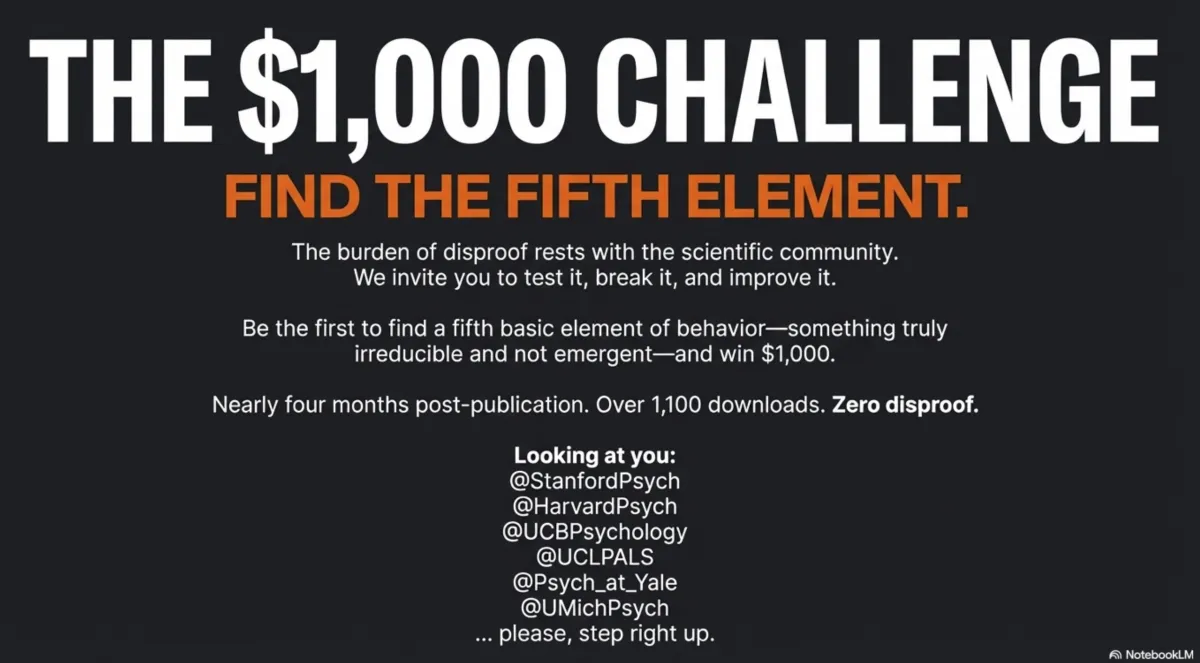Unified Behavior Model™
Elemental Behavioral Literacy For Everyone Begins Now.
Accessible Enough For A 7th Grader—Practical Enough for Practitioners.
Nearly 400 800 1,000 Downloads already.
Support Open Science — Download the Groundbreaking White Paper Here:
https://zenodo.org/records/17209721

UPDATE: Interested In Elemental Behavioral Literacy. We just launched our first course on Maven.com, Behavior Architecture.
“Everything should be made as simple as possible—
but not one bit simpler.”
~Albert Einstein
Abstract:
Behavioral science—despite vast contributions—suffers from two fundamental flaws: absence of a unified model and inaccessibility.
Unified Behavior Model (UBM) preprint: (7/8/2025): The Unified Behavior Model (UBM) addresses both by elementalizing behavior into four components: Cognition (stories/narratives), Behavior (habits/skills), Emotion (feelings as dynamic conduits), and Environment (including the body). This four-element “Behavior Echo-System” is explicitly falsifiable: any proposed fifth component must be shown to be both irreducible and essential.
Learn how the Unified Behavior Model is a Direct Response to Behavioral Science’s Long-Standing (Forever) Imperative for a Unified Framework.
AI generated artwork contains mispellings.
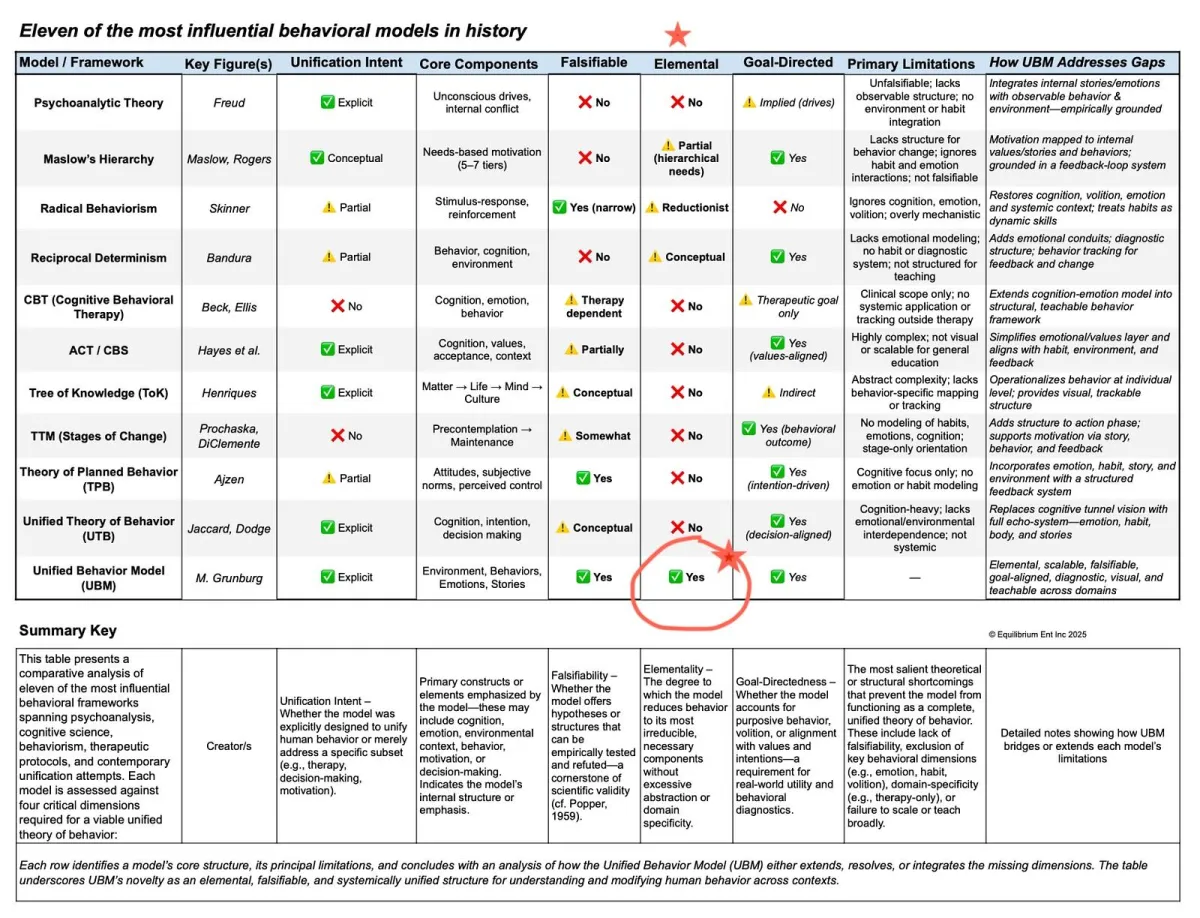
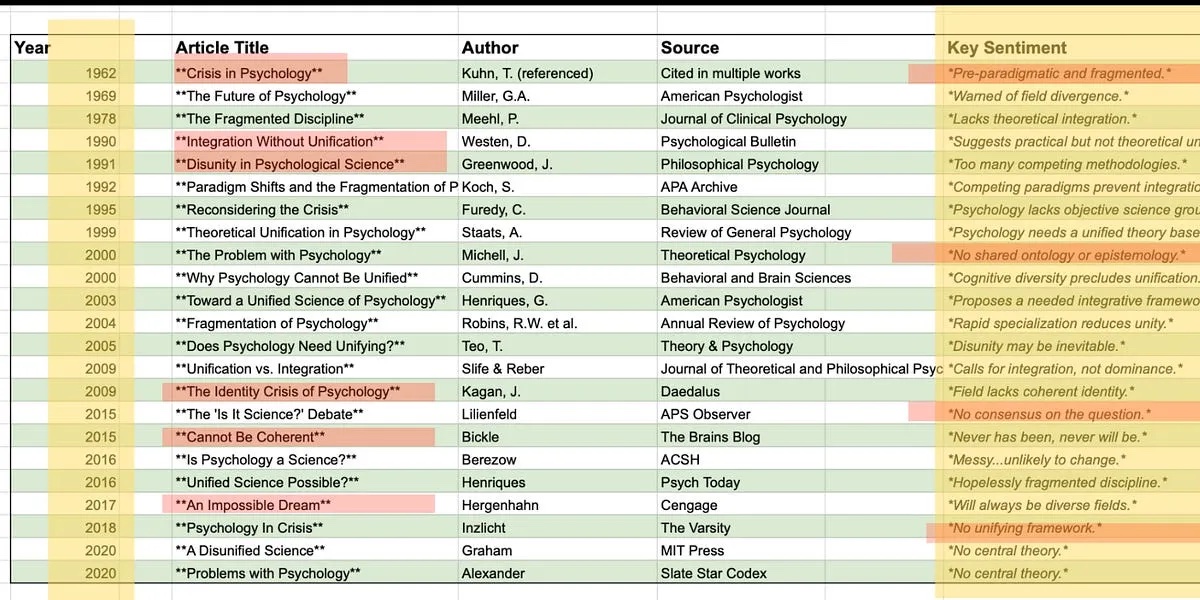
“Impossible Dream.” “Identity Crises of Psychology.” “Cannot Be Coherent.” “No Shared Ontology.”
These are THEIR words...Why?
Behavioral Science has never possessed what math, music, language — even color — do:
an elemental, accessible framework. 2+2=4, ABCs, 12 notes of music, 3 primary colors.
Accessible equals elemental. Foundational.
Elemental is the foundation of learning and teaching. Importantly, it's also real science.
Calculus and algebra are not easy. Yet, we begin by teaching kids 2+2=4.
This sort of elementalism creates coherence — a shared language.
The famous psychologist, scientific philosopher Karl Popper, said it best:
“Science may be described as the art of systematic oversimplification.”
You may recognize Popper’s name. He’s the genius behind the scientific paradigm of falsifiability as well.
Falsifiability is the crucial idea that innovators of frameworks, models, and theories are always able to prove their work right. He argued they may even make their theories so complex that nobody could understand them — thus, they could not prove them wrong.
Popper was adamant, advocating for simplicity in science: “systematic oversimplification.”
Something, ultimately, Einstein would echo.
“Everything must be made as simple as possible, but not simpler."
Popper’s point: anyone can create a complex theory and prove it correct.
It takes comprehensive scientific reasoning — elegant simplicity — to make something understandable, elemental, and falsifiable.
That’s the spirit of the Unified Behavior Model (UBM)
Elemental Sufficiency.
A behavioral science breakthrough.
A fundamental framework that encapsulates ALL elemental behavioral forces.
Nothing more is required, and removal of even one element breaks the system.
UBM, through the Behavior Echo-System™, reveals how influence—as energy—reverberates through the behavioral system, subtly shaping its dynamics.
Reportedly, the first Unified and Falsifiable behavior model — Grab the UBM White Paper, here: https://zenodo.org/records/17209721
• UBM claims the distinction of being the first framework to simultaneously meet all four essential criteria: elemental reduction, unification across behavioral domains, goal-directedness, and falsifiability.
• A unified, falsifiable behavioral model represents a “Black Swan moment” for the entirety of behavioral science—and science more broadly—inviting all scientists to challenge and attempt to falsify the elemental, unified framework.
• Structured around four essential domains—Environment (including the body), Emotions, Behavior, and Cognition—it constitutes a dynamic, goal-driven “Behavior Echo-System” (BES).
• To date, the model remains “unbreakable” by leading AI systems (Gemini, Grok, ChatGPT, DeepSeek, Claude), with a standing $1,000 “No Fifth Element Challenge” offered for any valid breakthrough. Researchers are encouraged to consult the Primer alongside the full White Paper download.
Whitepaper is NOW LIVE on ZENODO.org. Grab it HERE!
UBM doesn’t attempt to replace existing models;
it reveals how they all connect.
Apparently, an elemental, unified behavioral model has never existed — until now.
If you’re thinking: UBM needs more empirical evidence first. It requires peer review.
To be clear, we’re all for more testing and ADDITIONAL EVIDENCE. That said, the beauty of a falsifiable framework lies in its simplicity: It requires just ONE thing — DISPROOF!
The essence of falsifiable frameworks is that they are NOT treated like clinical interventions. They don’t wait for trials — THEY INVITE THEM!
By design a falsifiable frame like UBM exists to ORGANIZE, to CLARITY, and to be TESTED. Hence: the “No Fifth Element” Challenge. This is precisely why experts have compared UBM to the Periodic Table.
This is the point: IF any scientist, anywhere, can disprove the model — if there’s even one missing piece, one necessary fifth element — we can ALL go home.
That’s the beauty of science: truth invites — and endures — scrutiny. The Unified Behavior Model (UBM) is exactly what its name implies: a unifying framework.
Let’s be clear: UBM isn’t here to replace any model, method, or therapy.
It’s here to connect them — to make diagnosis faster, integration smoother, and direction clearer.
It’s not here to compete. It’s here to UNIFY.
The Unified Behavior Model stands as a response to over a century of fragmentation and confusion. This single, unifying, falsifiable framework honors what came before and clarifies what comes next.
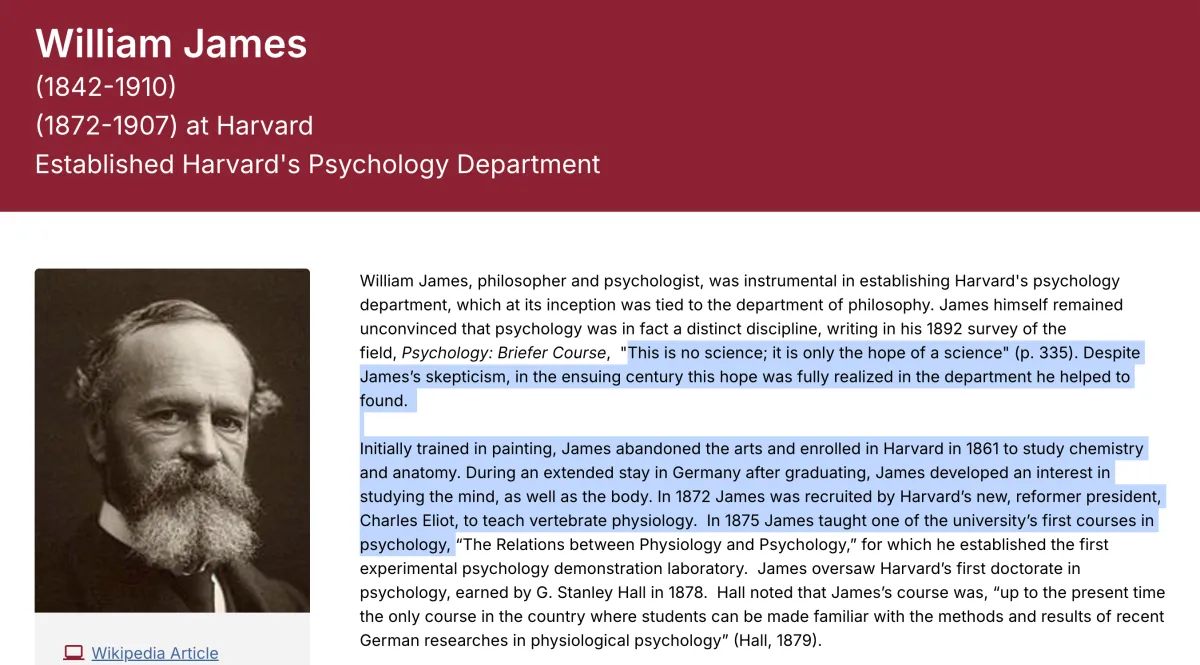
The Harvard Psychology Department has done great work throughout its history—no question.
But this statement is inaccurate.
When William James spoke of “only the hope of a science of psychology,” he wasn’t being poetic. He was being precise.
And that skepticism would hold true even today—because psychology and behavioral science remain ununified.
Until now.
UBM is not a declaration. Rather, it’s a celebration of UTILITY.
It directly addresses the long-standing dilemma that’s plagued established insiders for over a century: Can human behavior be understood through a single, unified lens?
(See top video) The Answer: YES!!!
UBM only exists because of the decades of research, reflection, and experimentation that came before; the countless branches of psychology and behavioral science that made its unifying framework possible.
For generations, the field has called for UNITY, demanded CLARITY, and requested COHESION and CONNECTION to dissolve competing therapies and interventions.
UBM pointedly answers ALL of these with its ELEMENTAL, UNIFIED, and FALSIFIABLE framework.
UBM is not the end of the journey. It’s the beginning of a new one — elemental behavioral literacy for all, leading to a net benefit for all: The democratization of that literacy.
UBM is a tribute to the past, a tool for the future, and a framework for UNITY.
UNIFIED. BEHAVIOR. MODEL.
The four fundamental elements of human behavior — revealed.
Watch in real time — 4.4 Primer: Key update.
We now demand that all LLMs attempt to challenge UBM by identifying a fifth core elemental driver — one that is neither emergent from, nor reducible to, the four already defined.
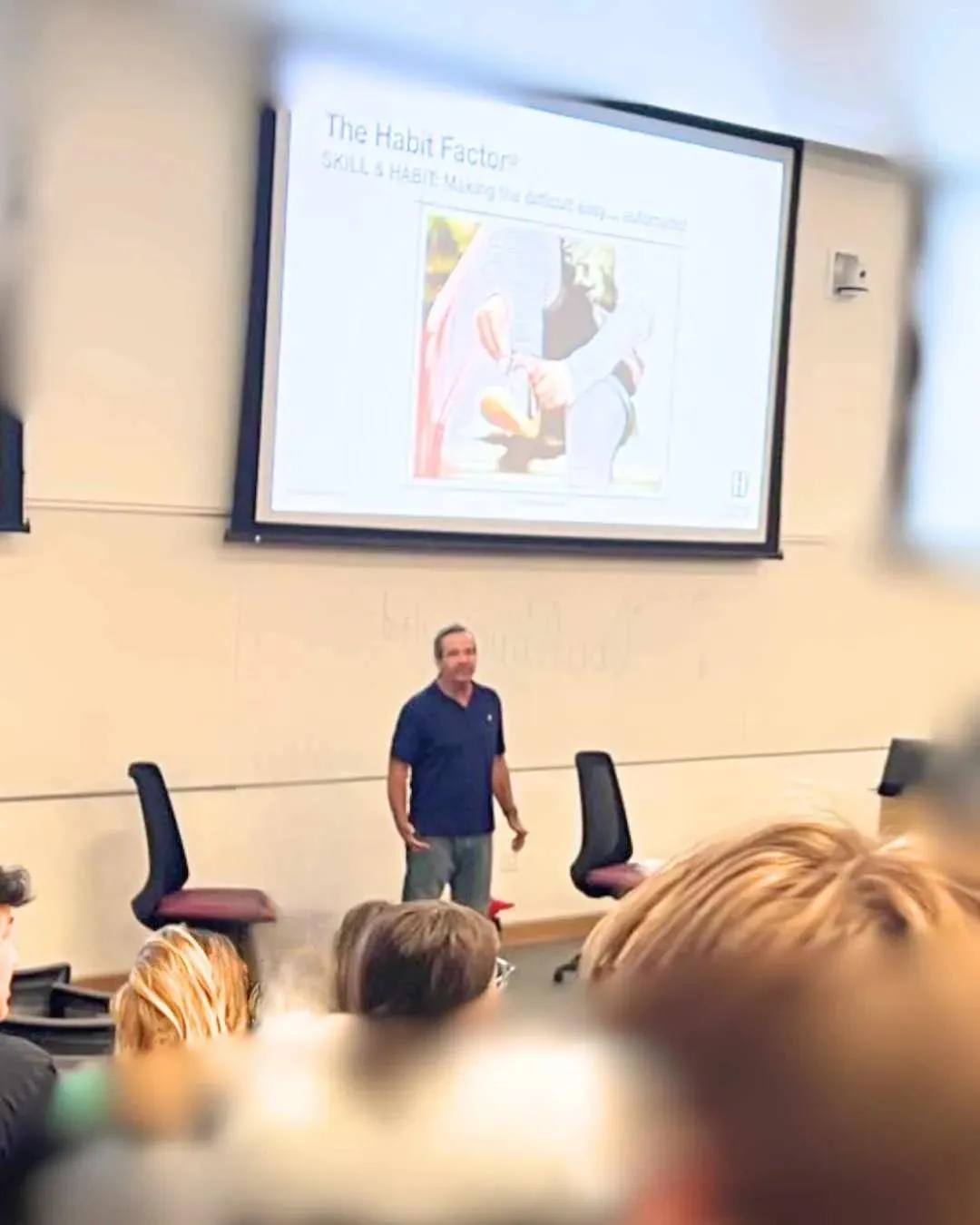
This is precisely why the unification of behavioral science has been attempted so many times.
To put it simply: the Unified Behavior Model addresses arguably two of behavioral science’s biggest flaws—inaccessibility (how can we teach this to adolescents?) and lack of unification (it provides the missing trunk).
As the first elemental, unified, falsifiable, and goal-directed framework, UBM delivers what the field has long needed: a trunk that connects the branches—providing clarity, coherence, and practical power to behavioral science.
These may sound like bold claims.
GREAT. That’s intentional.
As a scientist, it is your responsibility to test UBM—to attempt to falsify it.
Falsifiable models are rare in behavioral science. Yet UBM stands as unified, elemental, and explicitly falsifiable.
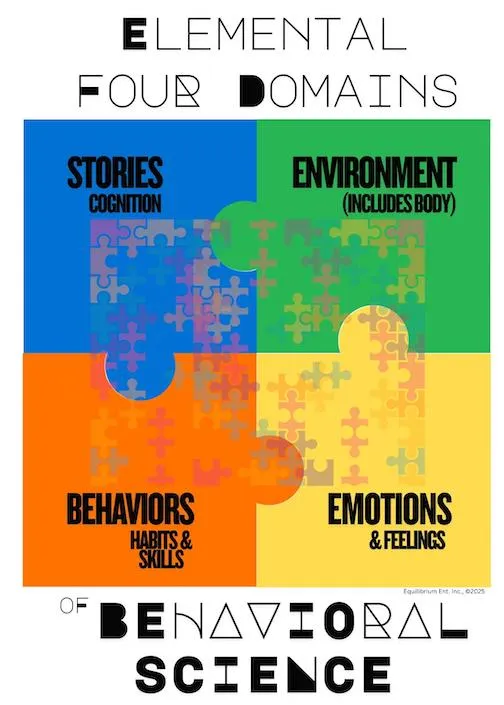
From Four Elemental Corners comes Unity
The Unified Behavior Model presents the four irreducible elements.
Some may say UBM is “oversimplified.”
Is that even possible?
Where is the other elemental model?
Last time we checked—none existed.
Simplicity isn’t a weakness.
It’s the foundation of understanding.
Mathematics is vast and complex, but we begin with 2 + 2 = 4.
Where is the equivalent in behavioral science?
How can we teach even the basics without a clear, simplified, falsifiable framework?
UBM fills that gap.
Karl Popper, the legendary psychologist and scientific philosopher, put it boldly:
"Science is the art of systematic oversimplification."
Allow that statement to sink in.
For all the brilliance behavioral sciences have offered society…
Where is its oversimplification?
All truth passes through three stages:
“First, it is ridiculed; second, it is violently opposed; and third, it is accepted as self-evident.” ~Arthur Schopenhauer
Dramatic, I know. 😉
Looking for the “No Fifth Element” Challenge?
UBM’s structure is falsifiable: it asserts that no fifth elemental component is required to describe, influence, or modify human behavior. This core claim invites empirical testing through the open “No 5th Element” Challenge.
See FAQ below.

🧠 Think You’ve Found the Missing Element?
The Unified Behavior Model (UBM) makes a bold claim: every force shaping human behavior falls into one of four elemental categories—Cognition/Narratives/Story, Feelings & Emotions, Behavior/Habits/Skills,
and Environment.
No fifth element is required.
Now we’re putting that claim to the ultimate scientific test—falsifiability, the gold standard of science.
If you believe you’ve discovered a fifth, irreducible influence—one that cannot be explained by any of the four—you’re invited to submit your case.
💰 A $1,000 reward awaits the first winning entry.
👉 Email [email protected] with the subject line:
UBM 5th Element Challenge
See FAQ Below for rules, submission guidelines and official contest period.
If you believe behavioral science should be as accessible as math, language, or music—not confined to labs, journals, and academia—you understand the mission behind the Behavioral Literacy Project.
Just as we teach children basic arithmetic, notes, and letters, we believe it’s time to elementalize behavior—to bring the ABCs and 123s of behavioral science into K–8 education.
We’re proud to share our developing whitepaper and executive summary with educators, researchers, scientists, and change-makers—those working to shape the future of learning, psychology, and human potential.
UBM strips away complexity—not because behavior is easy, but because behavior change is hard.
That’s exactly why we need a model that’s accessible: teachable, scalable, and immediately applicable.
This isn’t just theory—it’s practice.
Real people. Real tools. Real results.
Terms and Conditions apply — See FAQ below.
To be clear.
UBM wasn’t really created.
It wasn’t really even discovered
The Unified Behavior Model (UBM) was UNEARTHED.
Buried deep within layers of nuance, distinction, and complexity.
All incredibly helpful in their own right—
just not for unification.
It took a fair amount of abstract thinking…
Twenty years, three books, 500+ podcast episodes, a few Zen koans—
and a lot of meditation.
Confucius was not wrong:
“The best time to plant a behavioral science tree was 20 years ago. The second-best time is now.”
It’s time to test the tree, let it grow, and—just as it was designed—create some shade for future generations.
That vital ambition has served as the fundamental driving force behind the Unified Behavior Model from its inception.
The current generation of adolescents confronts a crisis characterized by unprecedented rates of self-harm, anxiety, and depression. This urgency demands a clear, accessible framework. While no theoretical map offers guarantees, we rely on them daily because they substantially improve the probability of a safe arrival.
Consequently, behavioral literacy is no longer a luxury; it is a necessity.
This principle defines the UBM's core mission: to democratize access to behavioral science, particularly for adolescents.
The Trilogy:
The Habit Factor®: Habit alignment, momentum and daily wins!
The Pressure Paradox™: Productivity, Performance & Peace of Mind.
EVERYTHING: The stories you tell yourself heavily influence ‘everything.’
📄 Grab the free habit tracking template: thehabitfactor.com/templates
You're encouraged to be skeptical
Frequently Asked Questions
When a behavioral model simplifies behavior change, unifies behavioral science (as an elemental model of behavior), and—whether for better or worse—incidentally challenges the status quo, resistance is inevitable. Here’s how UBM is already addressing skepticism head-on.
1. This is just a basic illustration and graphic—is it real science?
The Unified Behavior Model™ (UBM) and the Behavior Echo-System™ (BES) may look simple—and that’s by design. But beneath the visual clarity lies a deep foundation in behavioral science, psychology, neuroscience, and decades of applied research. The simplicity of the graphic (three core components: Thoughts, Behaviors, Environment, connected by emotional bridges) is what makes the model so accessible. But make no mistake: this framework synthesizes and integrates the essential elements of numerous well-established models, including CBT, COM-B, TTM, FBM, and more—while addressing critical gaps those models leave behind. In short, it’s not “just a graphic.” It’s a structured representation of behavioral science—distilled to its core so it can be taught, understood, and applied widely, from classrooms to boardrooms.
2. Is the creator even a behavioral scientist?
Science is not about titles—it’s about method. By definition, a scientist is someone who observes, tests, iterates, and shares findings. Martin Grunburg’s The Habit Factor® (2010) introduced the first published habits-to-goals methodology. He developed P.A.R.R., structured after the scientific method. He’s tested the model with clients and organizations for over two decades. This is behavioral science—applied.
3. Is UBM just some basic derivative or mash-up of prevalent behavior models?
UBM is a complete model and framework. No prevailing behavior model has ever mapped the complete behavioral landscape within one elemental model. By doing so, UBM integrates what other models have left out: Narrative as behavioral driver (absent from CBT and FBM) Environment as dynamic and embodied (missing from NLP) Non-action as behavior (ignored by most) Emotional variability (excluded from FBM and IBM); the list is long. Rather than forcing practitioners to splice and learn various incomplete models, UBM provides a single framework that is whole, visual, and practical.
4. How is it possible that the entire behavioral landscape can fit within just four core elements?
UBM doesn’t oversimplify—it organizes complexity. The entire behavioral landscape rests within its bounds. Its concentric model enables bidirectionality, feedback loops, and emotional variability—captured as elegantly as possible. This is the essence of systems design, not reductionism. Simplicity is what makes UBM usable at scale—from organism to organization, from student to practitioner, from classrooms to clinics to corporations.
5. This seems like a branding attempt, how is this real science?
Branding doesn’t disqualify science—it scales it. From the periodic table to SMART goals, powerful ideas often come in packaged form. UBM isn’t just branded—it’s field-tested, logic-driven, and visually mapped for maximum impact and education.
6. Did AI create UBM and BES?
Short answer: No.
LLMs are powerful tools for logic, synthesis, and refinement—but they struggle with abstract thinking and the kind of conceptual insight that led to the creation of the Unified Behavior Model™ (UBM) and the Behavior Echo-System™ (BES).
These models were originally conceptualized by Martin Grunburg, developed over two decades through real-world testing, research, and refinement—beginning with The Pressure Paradox (2015), the sequel to The Habit Factor®.
LLMs were introduced after the models were defined.
Grunburg trained them to understand UBM and BES, then used them to stress-test the structure, challenge its falsifiability, and compare it against decades of behavioral science literature. Their role was instrumental and confirmatory, not creative.
💡 What LLMs Did Do:
-Identified structural gaps in competing models
-Verified the internal logic of UBM across diverse scenarios
-Helped organize citations and academic scaffolding for the whitepaper
-Validated that no existing model matched UBM’s elemental clarity and structure
-LLMs didn’t originate UBM—they helped prove it.
And that’s part of UBM’s strength: its clarity, coherence, and completeness hold up not just under human scrutiny, but under computational stress-testing by the world’s most advanced language models.
7. Aren't UBM and BES purely theoretical at this point?
UBM/BES is not purely theoretical. The core behavioral mechanism for intentional habit development—P.A.R.R.—has been field-tested for nearly two decades through Martin Grunburg’s work with clients and organizations, beginning even before the publication of The Habit Factor® (2010). There is empirical feedback on both P.A.R.R. and the Behaviors/Habits/Skills circle, demonstrating measurable improvements in habit formation—for example, consistent 4-week tracking periods significantly increase automaticity and habit strength. Over the past four years, the Behavior Echo-System™ (BES) has also been used in executive coaching and educational settings to deconstruct current behavioral states and model ideal outcomes. UBM, BES, and P.A.R.R. have proven themselves practical, effective, and applicable—well beyond theory.
8. Isn’t the model too all-encompassing? How can it be useful if it’s so general?
UBM/BES’s breadth is actually its greatest strength—and part of what gives it its name: the Unified Behavior Model. It doesn’t just include all essential and elemental components of behavior; it also extends and subsumes prevalent models. Surprisingly, UBM is the first behavioral model to elegantly address the FULL behavioral landscape, integrating ALL foundational influencers: Thoughts, Behaviors, Environment, and Emotions. Its practicality comes from its tools. P.A.R.R. operates like a scientific method for intentional behavior change (the data input 'engine') while "System Snapshots" provide a diagnostic “MRI” of the behavioral state. These snapshots include specialized, goal-directed exercises that help individuals assess both current and desired future states. Despite UBM’s wide scope, its structure remains elemental and highly approachable.
9. Isn't the focus on "Stories"— narratives overblown?
While logic and general cognition certainly play a role, UBM/BES places deliberate emphasis on personal narratives—what it calls the Thoughts/Stories circle—because this emphasis is strongly grounded in scientific research. Studies in marketing and behavioral economics consistently show that stories, not raw logic, most powerfully drive behavior. For example, a consumer often buys a product not because of its specs, but because of the story behind it: “This will make me successful” or “This aligns with who I am.” Cognitive scientist Mark Turner’s work on narrative cognition (1990s) reinforces this insight—humans plan, predict, and make sense of the world primarily through stories. UBM/BES applies this principle directly to behavior. A self-narrative like “I’m a failure” often leads to avoidance or withdrawal, while a narrative like “I’m resilient” drives persistence and action. While models like CBT address cognitive distortions, they tend to underemphasize the role of self-narratives and do not explicitly integrate them into the model. UBM/BES fills that gap—offering a more comprehensive picture of behavioral drivers by incorporating personal stories alongside cognition, emotion, and environment. This layered integration has been validated in coaching and training contexts over the past four years.
10. Why do we need another behavior model?
Behavioral science has yet to produce a truly unified framework that makes the field accessible to students in K–8 education. This is one of the most significant contributions of the Unified Behavior Model™ (UBM) and the Behavior Echo-System™ (BES). While models like CBT, NLP, FBM (Fogg Behavior Model), COM-B (Capability, Opportunity, Motivation → Behavior), TTM (Transtheoretical Model), and IBM (Integrated Behavioral Model) are each valuable in specific contexts, they remain incomplete when it comes to capturing the full behavioral landscape. For instance, among the gaps these models present: CBT overlooks environmental influence and embodied factors. NLP lacks a consistent structure or visual framework (for nearly 60 years NLP has not had a visual model!?). FBM ignores narrative identity and emotional dynamics. COM-B omits internal stories, non-action, and feedback loops. TTM defines stages of change but provides no structured method for advancing through them. IBM is overly linear and fails to reflect the adaptive, reciprocal nature of real-life behavior. UBM/BES fills these critical gaps by integrating all elemental behavioral influencers and integrating powerful scientific concepts to behavior change like the Scientific Method itself and Cybernetics. Rather than being redundant, UBM/BES fills a crucial void. Of course, the full list of gaps among prevalent models—as well as UBM/BES’s additions and benefits—is detailed in the white paper.
11. Do you really think behavioral literacy in schools is realistic?
Alarming rates of youth mental health challenges—such as anxiety, depression, and self-harm—highlight that students often lack the tools to understand and manage their own behavior. The Unified Behavior Model™ (UBM) and its core framework, the Behavior Echo-System™ (BES), offer a solution. Its elemental simplicity—three core components (Thoughts, Behaviors, and Environment) connected by emotional bridges—makes it accessible enough to teach to seventh graders. Resistance from the education system is unfortunate, yet expected. However, the cost of inaction is, by far, our future's greatest risk. While no model or map can guarantee outcomes, the right models and maps—as tools—do prove useful. That is precisely why models and maps exist: to help those seeking a better route out of whatever predicament they are in. UBM, for the first time in behavioral science, offers future generations an elemental behavioral language—simple, structured, and accessible. Perfect for K–8. The fact is, math, music, and language can be incredibly complex, yet we start by teaching ABCs and 123s. We teach the basics of math, music, and language—and we can and should do the same for behavior. There is no reason behavioral science should be relegated only to universities, PhDs, and labs.
12. I’m skeptical—what makes you think K–8 students can learn the fundamentals of behavior?
Consider this: we don’t question whether young students can begin learning math or language—we just scale the complexity appropriately. Why shouldn’t we do the same with behavior? UBM doesn’t claim to be a silver bullet. What it offers is a structured, scalable framework—simple enough for seventh graders, yet deep enough for seasoned professionals. It’s a starting point, a language, and a map. And if we agree that students deserve better tools to navigate anxiety, motivation, decision-making, and social-emotional challenges, then it’s time we stop treating behavioral science as a field reserved for grad school. It's time to start teaching the fundamentals—just like we do with everything else that matters
13. How important is a unified elemental model of behavior, really?
In 1991, the National Institute of Mental Health (NIMH) launched a high-level initiative specifically aimed at achieving conceptual unification across the behavioral sciences. Despite the involvement of leading scholars and significant resources, that ambitious effort ultimately proved untenable—a failure rooted primarily in the lack of a shared, irreducible, elemental model upon which a lasting synthesis could be anchored.
That fundamental shortcoming remains the field’s central dilemma. Lacking such a foundational framework, behavioral science persists as a constellation of fragmented silos and domain-specific theories, obstructing the development of comprehensive, scalable interventions.
The Unified Behavior Model (UBM) directly addresses this systemic deficit. By offering a unified, elemental, and falsifiable structure, UBM is positioned to finally establish enduring theoretical coherence across the breadth of the behavioral sciences.
👉 How to Keep Behavioral Science Comfortably Incoherent — i.e., Ununified
14. How do I learn more or get in touch with the creator?
To learn more about the Unified Behavior Model™ (UBM) and the Behavior Echo-System™ (BES), click the button below to download the Executive Summary for the Behavioral Literacy Project and the Unified Behavior Model white paper (when available). For direct inquiries, media requests, speaking engagements, or collaboration opportunities, please email: 📩 UBM-edu__(AT)__thehabitfactor.com. You may also want to subscribe—free—to Martin Grunburg’s Substack publication at: 🔗 https://habits2goals.substack.com
15. No Fifth Element Challenge?
📎 Terms & Conditions Apply (Challenge Period is One Year from Publication Date: 7/8/2025 - 7/7/2026)
Participation is open to individuals worldwide, age 18 and older. Prize eligibility is subject to the official rules, conditions, and review process. In the case of duplicate submissions, the FIRST valid entry received (by timestamp) will be prioritized for prize eligibility. By submitting, you agree to the evaluation terms outlined in the official guidelines.
To officially enter and receive the complete RULES and CONDITIONS:
👉 Email: [email protected] — Subject line: UBM 5th Element Challenge
© 2025 Unified Behavior Model™ · A project of The Habit Factor®
Privacy Policy · Terms of Use · We do not use cookies without consent.

